The post My What A Big Claw You Have! All the Better to Love You With. first appeared on Deep Sea News.
]]>![Fiddler crab (uca leptodactyla) in El Guamache, Margarita Island, Venezuela. By The Photographer (Own work) [CC0], via Wikimedia Commons](https://www.deepseanews.com/wp-content/uploads/2016/07/Fiddler_crab_2-600x415.jpg)
For fiddler crab males, size is everything. Well over 60 different species of fiddler crabs, genus Uca, exist across the globe. You are probably familiar with the crabs. The males have one ridiculously large claw. You might think I’m being unfair to fiddler crabs, but the claw of male fiddler crabs is one of the most exaggerated, sexually-selected structures of animals. That ginormous claw can exceed 1/3 of total body size in large males. For perspective, that is the equivalent of a 200-pound human male having a hand that weighs 66 pounds. The average weight of human male hand is 1.25 pounds. So yeah I think ridiculously large is an apt description.
So why gargantuan claws? To attract the ladies of course. Male fiddler crab wave their claws about, held high above their head to attract females into breeding burrows. Each species as unique claw wave. Uca longisignalis, the fiddler crabs right aside my window here at the marine lab in southern Louisiana, stands outs because of numerous small jerks, sometimes reaching more than 30, that occur before the raising of the claw. Uca musica, a fiddler crab from the tropical Pacific, conducts a prominent circular motion with its claw during a display. In my Louisiana fiddler crab, Uca longisignalis, the circular motion is weak at best, clearly needing some practice.
Why are the claws so important to the fiddler crab ladies? In part males with larger claws are more likely to win contests, much more a ritual than an actual fight. To the winner goes the spoils. In this case the spoils are prime burrows in the mud flat, important both as bunkers during hide tides and nurseries. Wandering pregnant females actually choose males partly on the basis of the respectability of the burrow. Of course bigger claws are quite frankly just more visible to females. Interestingly, despite the large claw primarily being just for show, the equivalent biological bling, the claws are still functional and quite capable of generating enough Newtons of force to successfully cut the author’s index finger.
In a great 1996 study by Jennions and Blackwell, males of Uca annulipes were removed from their burrows and released back into the colony. The two researchers then monitored the fighting success between the residents of the burrows and the released intruders. Intruders with relatively large claws for their body size won more fights. However, not just claw size that mattered. Released intruders initiated encounters more frequently with burrow resident males smaller than themselves. When the intruder was larger than the residents, the intruder was more likely to win. The bigger the loser or winner in any fight the longer the battle goes. Another study by Blackwell and Passmore, found females not only are particular for larger claws but larger males as well. At the beginning of a mating period, females selectively go for the larger males in the population. Toward the end of the mating period, when females feel the pressure of mating in time to release young to coincide with the following nocturnal spring tide, they become a little less choosy for big males.
The ladies love big claws and big males.
The post My What A Big Claw You Have! All the Better to Love You With. first appeared on Deep Sea News.
]]>The post The Odd Nautilus Organs Named After People first appeared on Deep Sea News.
]]>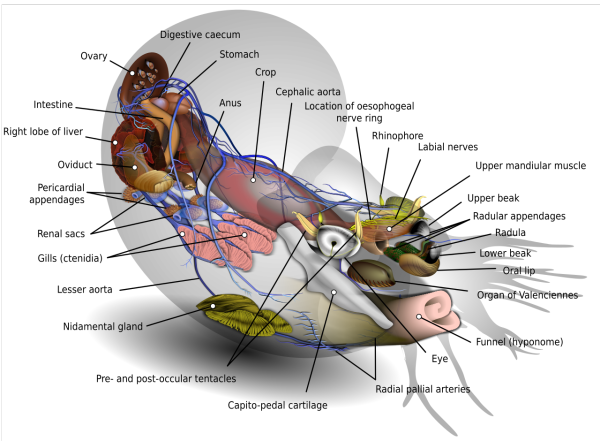
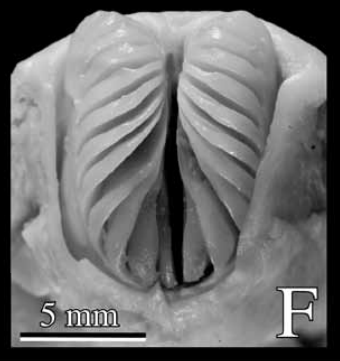
The Chambered Nautilus, Nautilus pompilius, was originally described by Linnaeus in 1758. However its anatomy was not known until Richard Owen’s dissection of a specimen captured by sailors in the New Hebrides, published in 1832. Owen wrote a 125 page tome, Memoir on the Pearly Nautilus, Nautilus pompilius, Linn., on every aspect of the Nautilus. Owen was a prolific British naturalist best known for coining the word Dinosauria.
Achille Valenciennes was a French zoologist who lived from 1794–1865 and studied under the famous Georges Cuvier. Valencienne published on the Nautilus in 1841.
Last, is the a Dutch zoologist Jan van der Hoeven who published extensively on Nautilus in the 1850’s.
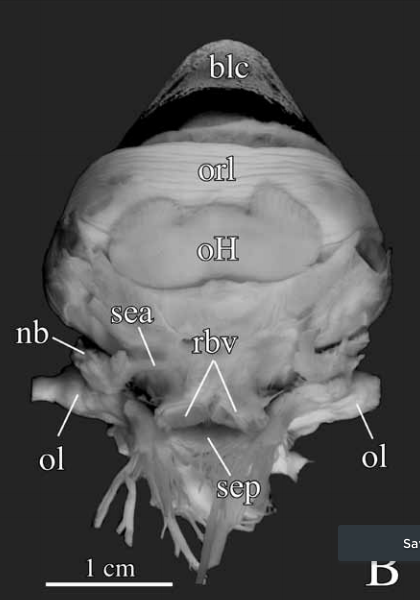
One of these organs is a distinctive projection that sits below the buccal mass (mouth and pharynx). Because the shape and structure of the organ differs between males and females the organ is probably linked to reproduction. In females, the organ is divided into two ridged and grooved structures and called the organ of Valenciennes. In males, the organ is a undivided flap termed the organ of van der Hoeven. It is thought that both organs may be glandular. However, Jon Arnold in his chapter “Reproduction and Embryology of Nautilus” notes the presence of spermatophores, sperm packets, coiled on the female’s organ of Valenciennes. This suggest the organ is analogous to the seminal receptacle, a sperm holding organ in female squids.
The last organ composed of varying layers, is also found in females below the buccal mass—the Organ of Owen. Interestingly, however, I find there is often little mention or discussion of the organ. Owen’s organ is found in Wiley’s well-known work in 1902. In 1975 Saunders and Spinosa mention the cryptic organ. More recently in 2010, Shozo Hay Asaka and colleagues also mention it briefly “whereas in females, the buccal mass is centrally located, along with accessory organs [labial lobe and Owen’s organ].”
Valencienne and Owen actually had a science beef over whether cephalopods should be compared by their suckers or tentacles.
French researcher Achille Valenciennes had proposed that naturalists should compare cephalopods by using their suckers instead of their tentacles. Owen disagreed. He responded that the cephalic tentacles of a Pearly Nautilus were numerous and comparatively small, indicating its lower place on the scale. Because development mean a reduction in number and an increase in size and ‘perfection’, Own pointed out that Valencieene’s proposal was not ‘comfortable with the general law of development,’ for it would reverse normal expectations. After all the lowly-organized Nautilus had two large and highly concentrated suckers on each tentacle, while more highly-organized cephalopods hat two hundred smaller or simpler suckers. Owen was confident enough to publicly reject Valencienne’s proposal by trotting out the common believe that higher development manet more coalesced parts, even though it was contradicted by the specific case of cephalopods suckers.
Given Owen’s rather pompous remarks, many of them wrong, perhaps it’s fitting that Valencienne’s organ is the one that received the most attention.
The post The Odd Nautilus Organs Named After People first appeared on Deep Sea News.
]]>The post This Is How We Do It first appeared on Deep Sea News.
]]>
With things such as penis fencing and massive sea hare orgies, I think we can all agree, the ocean does “it” in some pretty weird and marvelous ways. So in the spirit of sperm and gif week, I decided to compile some of the kinkiest and intriguing ocean romps, courting displays, and ‘techniques’ for your viewing pleasure. Don’t worry…it’s safe for work…No one will actually know what you are looking at and they probably won’t believe you when you tell them.
1. ‘Knock, Knock.’ ‘Who’s there?’ ‘Barnacle Penis.’ ‘Barnacle Penis whooooaaahhhh.’ Like one of those Facebook Instant Videos you just can’t stop watching, the longest member* of the animal kingdom prowls around looking for a likely mate. Being completely cemented down for almost all of their life, these crusty Casanovas had to figure out another way to carry on the family line.
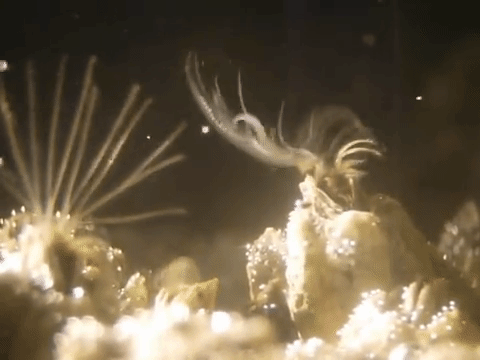
2. It’s a Torpedo! It’s a Worm! Actually…it’s a penis. Well, kind of. It’s more correctly termed a hectocotylus. Once an arm attached to the male Argonaut, a group of octopus that secrets a shell known as a paper nautilus, these organs are filled with sperm and ejected in search of a female suitor. Fully detached, they can free swim in search of a female pallial cavity and copulation can ensue. The ocean is weird people.
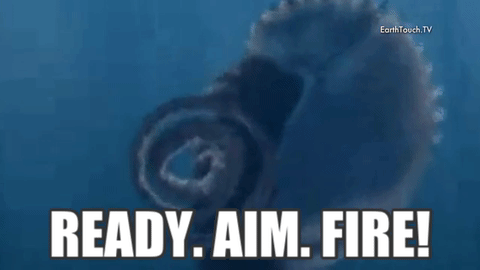
3. Flatworms are fierce lovers. Being hermaphrodites, they have both lady bits and man bits. But because raising flatworm babies takes so much effort and energy, no one wants the responsibility. So what do they do? They gouge each other with their man bits in a battle royale unlike any other. The fastest shooter in this situation is the winner and goes on floating about sex battling other flatworms, while the loser is stuck with the real world responsibilities of taking care of the kids.
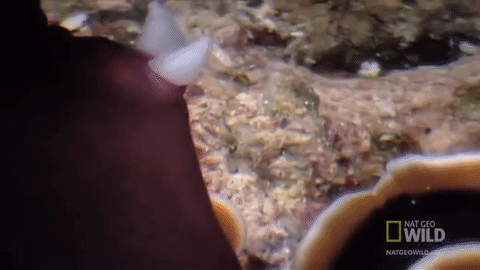
4. They might look all cute and innocent but Sea Hares are actually quite sexually promiscuous. They too are hermaphrodites and will join together in 50 shades of red to form long love chains of copulation. The impregnated individuals will then lay noodle-like pink eggs in large mats covering the ocean floor.

5. Many ocean-faring critters are Stage 5 Clingers when it comes to relationships. In certain copepod species, duration of when females can mate is a relatively small window. Males will latch on to the females and wait till this time comes, despite how annoying this might be for the female individual. Anglerfish males are also well known for a similar behavior, however in that instance they will fuse with the female entirely and are only used as baby making machines for the rest of their existence.
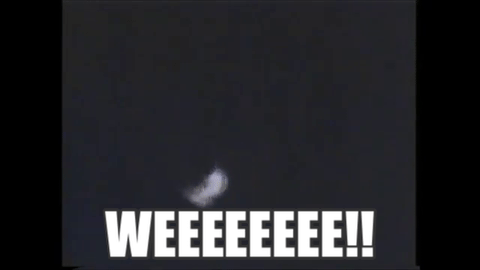
6. Perhaps one of the most beautiful courtship displays is brought to us by the Cuttlefish. Male Cuttles will attempt to impress the ladies by pulsing vibrant patterns across their mantles while defending territory on the reef. After a extensive display, it’s ladies choice and the fun begins.
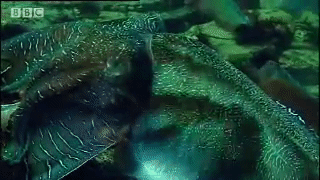
7. Male turtles use the small claws on their flippers to lock-in a female for mating. But what happens when you another guy comes around and thinks he’s a better suitor? Things. get. ugly…
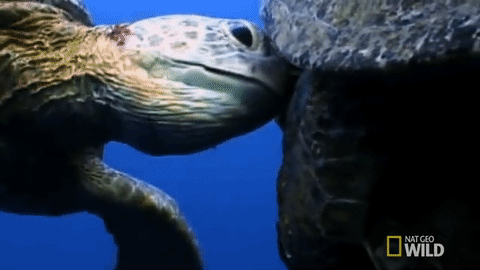
8. I believe I can fly!! I believe all the ladies are minnnnneeee! Mobulas, or Devil Rays as they are often referred, can school in the thousands. Sometimes they are observed jumping high out of the water. Though scientists are not 100% sure on the purpose of this behavior, one of the reasons purposed is as a sort of courtship dance or proof of prowess. The higher you can jump, the better you are…fathering mobula babies.
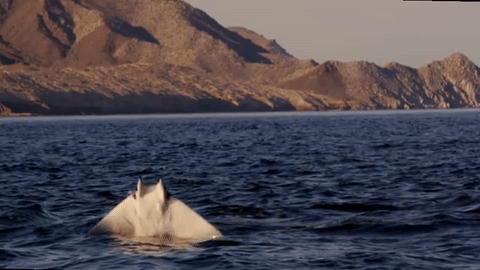
*Proportionally the longest at 8x times the body ratio
The post This Is How We Do It first appeared on Deep Sea News.
]]>The post The Id of the Squid first appeared on Deep Sea News.
]]>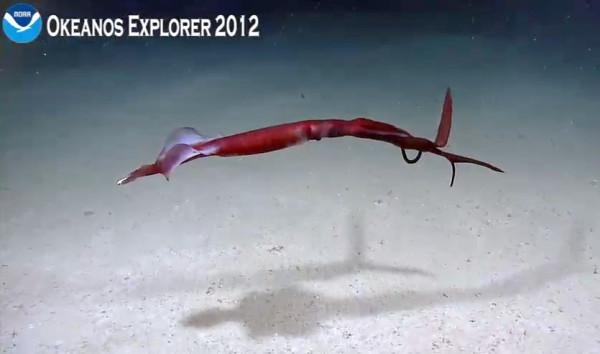 Does the squid consider with only revulsion
Does the squid consider with only revulsion
The prospect of sex under jet propulsion?
Or does he think it all slightly spectacular,
This flying embrace so tightly tentacular?
Or perhaps he is shy, so he cleverly thinks,
“Any loving we do will be hid by our inks.”
But when they embrace, whether flying or hid,
They’re a couple of crazy and mixed-up squid.
-Arch E. Benthic Id of the Squid and Other Outrageous Rhymes About Oceanography
The post The Id of the Squid first appeared on Deep Sea News.
]]>The post For Hoff Yeti Crabs Food, Sex, and Birth Determine Living Space At Vents first appeared on Deep Sea News.
]]>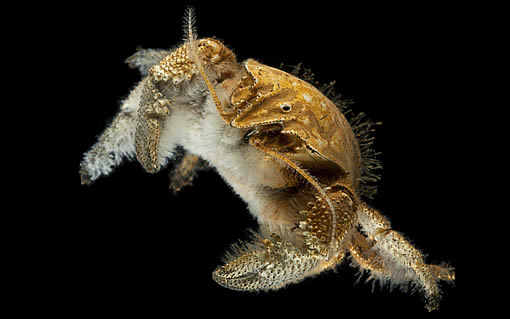 Within just a few short centimeters the temperature drops from 350˚C to -1.5˚C (692 to 29.3˚F). At 2.6 kilometers deep in the Antarctic Ocean lies the East Scotia Ridge (ESR) dotted with hydrothermal vents. Here, in this unique spot the world’s coldest ocean is in contact with one of the seafloor’s hottest environments. Life residing at hostile vents must live in an environment so thermally variable it rivals the temperature differences seen among the most hostile planets in our own solar system. Yet life flourishes here with amazing adaptations.
Within just a few short centimeters the temperature drops from 350˚C to -1.5˚C (692 to 29.3˚F). At 2.6 kilometers deep in the Antarctic Ocean lies the East Scotia Ridge (ESR) dotted with hydrothermal vents. Here, in this unique spot the world’s coldest ocean is in contact with one of the seafloor’s hottest environments. Life residing at hostile vents must live in an environment so thermally variable it rivals the temperature differences seen among the most hostile planets in our own solar system. Yet life flourishes here with amazing adaptations.
In the video a large Hoff crab covered in filamentous bacteria (00:01–00:18) Two large male try to lay the hurt on one another (00:18–00:41) Group B at the Carwash chimney (00:42-01:11).
In the video above a male Hoff Yeti Crab reacts to hot vent fluids
At the hottest spot, near the venting fluid, is the ‘A’ assemblage comprised of only very few of the largest males getting close to the vent fluid to fuel their bacteria and eventually their own growth. Larger males may be more successful in crab fight club beating out other males in getting out of the friend zone with females.
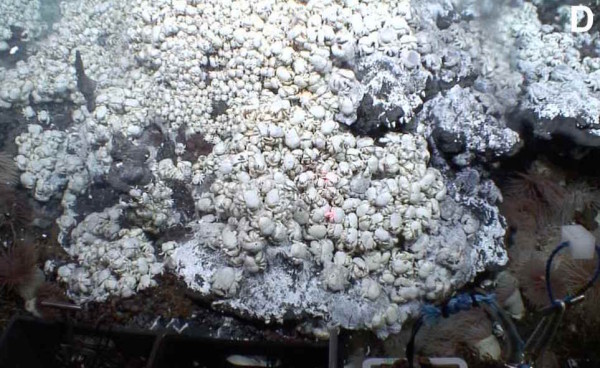 Further out from the venting fluid is the ‘B’ group, a mixture of medium size males and females. This coed party can be in the 100’s per meter squared. The majority of the females here possess ripe ovaries suggesting they are receptive to the sexual inquiries of the males. Further out again from the venting fluids is an additional coed party, ‘C’ group, and despite only being attended by the smallest of females and males densities reaches over 4,000 per meter squared. This area smells a lot like stale beer and hormones, is illuminated by glow sticks, and all overlaid with rhythmic pounding of the latest pop hit club remix. There ain’t party like a C group party because a C group party never stops.
Further out from the venting fluid is the ‘B’ group, a mixture of medium size males and females. This coed party can be in the 100’s per meter squared. The majority of the females here possess ripe ovaries suggesting they are receptive to the sexual inquiries of the males. Further out again from the venting fluids is an additional coed party, ‘C’ group, and despite only being attended by the smallest of females and males densities reaches over 4,000 per meter squared. This area smells a lot like stale beer and hormones, is illuminated by glow sticks, and all overlaid with rhythmic pounding of the latest pop hit club remix. There ain’t party like a C group party because a C group party never stops.
At the very periphery, far from the venting fluids and at the coldest temperatures, is a transition zone. Here, juveniles are in search of the venting fluids to sustain their harry bacteria. In addition, brooding females find refuge here for their young from the environmental extremes of the vent and potential damage from lusty crabs crawling all over each other.
In the video above an ‘A’ Group (00:41–01:05) A ‘B’ Group (left) adjacent to an ‘A’ group (right) at the “Black & White” chimney (00:41–01:05).
In short, males are driven by sex and food as you might expect from a crab with luxuriant chest ‘hair’. The females add the additional priority of actually carrying and caring about the young.
Marsh, L., Copley, J., Tyler, P., & Thatje, S. (2015). In hot and cold water: differential life-history traits are key to success in contrasting thermal deep-sea environments Journal of Animal Ecology DOI: 10.1111/1365-2656.12337
The post For Hoff Yeti Crabs Food, Sex, and Birth Determine Living Space At Vents first appeared on Deep Sea News.
]]>The post The Antarctic is a rough neighbourhood first appeared on Deep Sea News.
]]>
The image of a seal (those goofy ball-on-the-nose guys!) mounting a penguin (those dapper black and white gents with the endearing waddle) is so absurd as to be ostensibly hilarious, until you really think about what’s happening here, and then it’s not funny at all, just disturbing and fascinating. To start with, an adult fur seal is much larger and heavier than a king penguin and there’s a good likelihood that breathing of the penguin could be compromised from the weight of their attacker. But it gets worse because, like other pinnipeds, fur seals have a baculum or penis bone, which increases the degree of trauma that might result from a successful penetration. The gender of the hapless victim penguin (which was unknown for the reported cases and is hard to tell externally), would not really matter either because both male and female penguins have a cloaca or common opening that serves for solid and liquid waste disposal and also as the sexual portal of entry for normal carnal relations. I don’t know much about penguin intelligence or cognitive ability, but we should at least consider the possibility that this is psychologically traumatic for the penguin. Perhaps the ultimate moment of pause, though, comes when you read the researcher’s observation that in one of the instances, when the fur seal was finished raping the penguin, he killed it and ate it. That’s just brutal.
Why is this happening? The behaviour seems confined to sub-adult male fur seals and the researchers speculate that it may result from sexual frustration. Why then would a fur seal have blue balls? Probably because the dominant adult male in the colony is preventing them from mating with his harem of ten or more females. Fur seals are one of those pinniped species that has a “beach master” like this, so the social structure of a seal colony may predispose sub-adult males to this sort of behaviour. That’s consistent with other cases of (to use a heteronormative phrase) aberrant sexual behaviour in marine mammals, such as long term homosexual pairing in adult dolphins, blowhole sex and inter-species sexual aggression and rape between dolphin species. As one marine mammal biologist I spoke to put it, it appears that opportunities for apparently aberrant behaviours increase with increasing social complexity of the offending species. In this case, the penguins are in the wrong place at the wrong time and of the wrong approximate size and end up bearing the brunt of frustrated sub-adult seals. What makes this case so extraordinary is the giant taxonomic gulf between the two species; it’s one thing for a bottlenose dolphin to rape a spotted dolphin, but it’s another thing altogether for a mammal to rape a bird. It’s probably only possible because this particular bird is flightless and not all that formidable an opponent while on land.

One of the more interesting aspects of this behaviour is its potential role in the ecology of infectious disease (forgive me, but I come from an animal health background and when you’ve got a hammer, everything looks like a nail!). In one published example, bottlenose dolphins have problems with malignant oral and genital cancers that are caused by a papilloma virus and are sexually transmitted by the oral-genital contact that is common in the mating system of dolphins. When I look at the images of the seal raping the penguin, I see extraordinary behaviour, but I also see the raw material for the evolution of “host switching”, the process whereby pathogens and parasites can effect a jump from one host species to another. In this case it’s not a jump between species, but potentially between classes of vertebrates, and those opportunities may not come along all that often. So, beyond the immediate morbidity (and in one observed case, mortality) of this behaviour, it will be interesting to see if any long term changes to the health status of penguins (or fur seals, for that matter) in this population occur in the future. In the meantime it remains one of the more extraordinary bits of marine animal behaviour I have ever seen described.
Cited:
William A. Haddad, Ryan R. Reisinger, Tristan Scott, Marthán N. Bester, P. J. Nico de Bruyn (2014) Multiple occurrences of king penguin (Aptenodytes patagonicus) sexual harassment by Antarctic fur seals (Arctocephalus gazella). Polar Biology. 10.1007/s00300-014-1618-3
Bossart G.D. (2007) Emerging Diseases in Marine Mammals: from Dolphins to Manatees. Microbe 2: 544-549
The post The Antarctic is a rough neighbourhood first appeared on Deep Sea News.
]]>The post Sex, Snails, Sustenance…and Rock & Roll first appeared on Deep Sea News.
]]>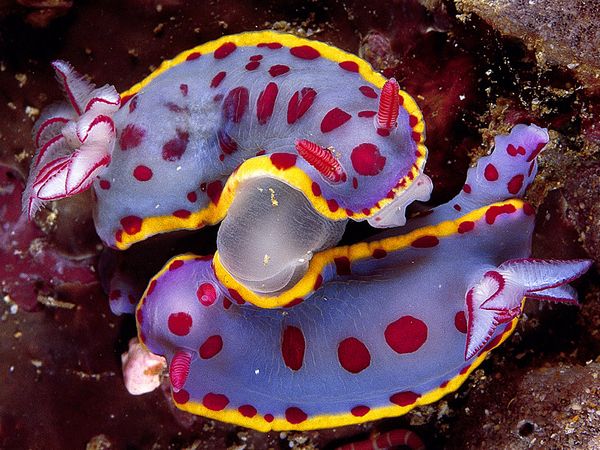
One of the things in the title was not actually part of my latest published research, unless you count the soundtrack I played while doing analyses. The research question was simple, how do the sexual lives and strategies for the subsequent offspring change depending on the availability of food. In the oceans, the amount of food ranges from a single M&M to the whole damn M&M factory. When the candy dish of single colored M&M’s is near empty, because that is what a true rocker would want, what is the most rock and roll thing a snail can do with it’s love life? Cuz they do feel like makin’ love. Conversely, when the night is young, the world is an open book, and you can bathe in tub full of tiny chocolate candies, how does a snail rock and roll all nite?
In the oceans, when the food is low then the population of snails must also be low. There is simply not enough food to support lots of snails. With mate choices at a minimum, better to be a hermaphrodite so any chance encounter can be a whole lotta love.
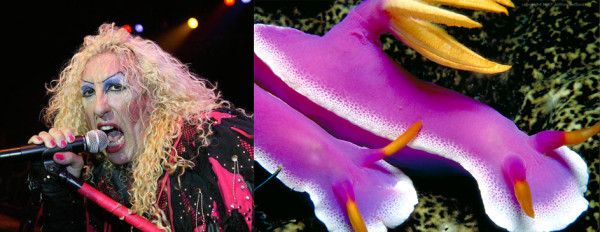
However, this is exactly the opposite of what colleagues and I found in a new study. Collecting data for almost 200 families of snails and the amount of food available to them in the wild, we found that hermaphrodites are found in greater frequency when food is in surplus. One of the reasons for this is that those showy nudibranchs, mainly hermaphrodites, dominate when food is great. Those flashy sea slugs, sort of the Dee Sniders of snails, have very high metabolic demands. They simply don’t do well where food is low. Much like I’m sure Twisted Sister never stayed in hotel that couldn’t supply them with a whole room of frozen cheesecake bites. Moreover, simultaneously producing eggs and sperm, i.e. always being ready to go, is also calorically expensive. In retrospect it doesn’t seem very rock and roll at all to be a hermaphrodite when food is low.
But what choices do snails make for their offspring in these two different eating scenarios? What will allow your offspring to grow up into full on rockers and ultimately throw a TV out their little snail hotel rooms? Let’s take a step back. A snail can produce three basic types of youth. Planktotrophic larvae are sent up into the water column and snack to their little “hearts” are content. Lecithotrophic larvae are sent into the water column but do not feed. Instead, the mother gives these little larvae a yolk snack to sustain them. Last, you can hatch maybe with a little bit of brooding little tiny adults.
What we found is that in regions of the oceans where food is low, snails that produce planktotrophic larvae dominate.
Producing offspring is costly…calorie wise. In the three scenarios above, planktonic larvae are the least expensive. The feed and fend for themselves. More importantly, the larvae feed elsewhere, away from the adults. When there are few M&M’s, you don’t have the young hanging around cramping your style. And because they are planktonic they can drift away and maybe find a better stash of tiny candies than was ever available to you. The other scenarios are more calorically expensive; one requires the adult to supply a yolk. The last scenario, direct development, is the most costly both to produce large young but to care for them as well.
The only thing to do now is to light a couch on fire.

Now the paper and a Spotify music list to inspire you
McClain, C., Filler, R., & Auld, J. (2014). Does energy availability predict gastropod reproductive strategies? Proceedings of the Royal Society B: Biological Sciences, 281 (1789), 20140400-20140400 DOI: 10.1098/rspb.2014.0400
The post Sex, Snails, Sustenance…and Rock & Roll first appeared on Deep Sea News.
]]>The post We found love in a hopeless place. first appeared on Deep Sea News.
]]>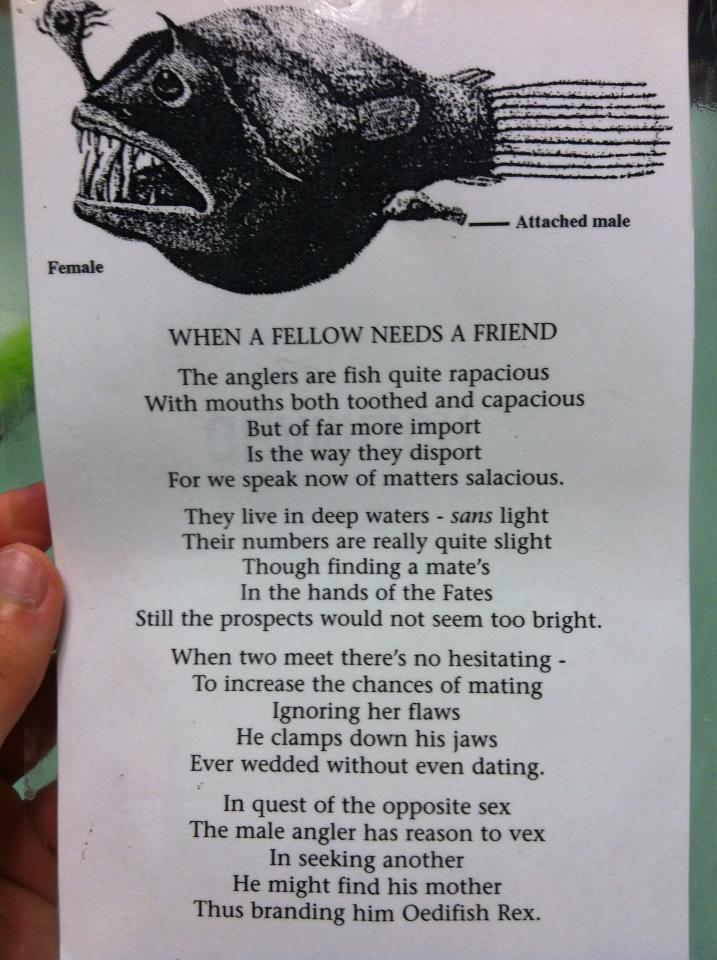
The post We found love in a hopeless place. first appeared on Deep Sea News.
]]>The post Nothing says let’s get it on… first appeared on Deep Sea News.
]]>…like a good pee to the face.
For some girls it’s as easy as chocolate and roses. For others you might have to work a bit harder, break into your inner culinary genius, and splurge on a candle or two. However, for certain females of the spineless variety, nothing gets them more riled up than getting a great big whiff of bittersweet male excrement.
Sound gross? Well it is, but that’s the life of many crustaceans, lobsters in particular.
Finding a suitable partner in the big blue can be a relatively difficult task. Sites like “invertharmony” and “plentyoffish.com” just don’t exist for all the single lady lobsters out there. (Though apparently the latter is a real thing. Link here: POF.com) Thus, when it comes to needing sexy time and finding a fine, fit friend to populate the species, these ladies rely on the next best thing, their chemosenses.
Male American lobsters, Homarus americanus, will release urine from small ducts, called nephropores, positioned on the fronts of their faces. This pheromone-infested pee has all sorts of reliable information for lady lobsters to locate and evaluate the reproductive quality of their male prospects. Originally, researchers though it was the other way around and that males were the one’s doing the choosing. Let’s be honest with ourselves though…even if we let them think they have the power…it is always “ladies choice.”

How to catheterize a lobster’s nephropores and collect their urine for use in experiments.Source: Breithaupt et al. 1999
Sniffing out a strong, dominant male is essential. Not only does this ensure the future success of the lady lobster’s prodigy, but it can also be beneficial for her protection. Once she has made her pee-based choice, the lady lobster will molt and shed her hard shell, leaving her soft, vulnerable, and ready to get jiggy with it. After the deed is done, the male will protect the love nest until the lady lobster has hardened and is back on her feet.
This type of odorous courtship communication is quite complex in this species and other crusties (crabs, crawdaddies, etc.). Researchers speculate that successful mating is most likely based on a variety of chemical signals produced by both the males and the females. However, one thing is relatively certain…it all starts with the pee in the face.
For all the guys out there…just a fair warning for your Valentine’s Day escapades…I don’t know if this works on the ladies at the bar … unless you’re R.Kelly, I wouldn’t try this at home.
REFERENCES
Breithaupt, Thomas., Lindstrom, Daniel P., and Atema, Jelle. Urine release in freely moving atheterised lobsters (Homarus americanus) with reference to feeding and social activities. The Journal of Experimental Biology 202 (1999): 837-844.
Bushmann, Paul J. and Atema, Jelle. Chemically mediated mate location and evaluation in the lobster, Homarus americanus. Journal of Chemical Ecology 26, 4 (2000): 883-889.
Cowan, Diane F. The role of olfaction in courtship behavior of the American lobster Homarus americanus. Biology Bulletin 181 (1991): 402-407.
The post Nothing says let’s get it on… first appeared on Deep Sea News.
]]>The post 10 Ocean Species That Challenge Gender Role Stereotypes first appeared on Deep Sea News.
]]>Th example might be an obvious one but worth the mention. Male seahorses possess a pouch on their frontside, similar to kangaroos. During mating, the male will pump seawater into the pouch to expand and reveal its sad emptiness to the courting female. The female, feeling very bad about the emptiness, will then deposit eggs into the pouch. She does this deed with her ovipositor, an appendage for egg laying just like the one of the Alien Queen in Aliens. The male now washes the eggs in sperm. The fertilized eggs will eventually become embedded in the pouch wall and surrounded by spongy tissue. Gestation can last anywhere from 2-4 weeks. Using muscular contractions of the brood pouch, the male will birth the young seahorses. Depending on the species, males can give birth from 5 to 2,500 young.
2. Common Slipper Shell (Crepidula fornicata)-Gender Switching
Crepidula is a sequential hermaphrodite. During the same course of life, this limpet will change sex from male to female.
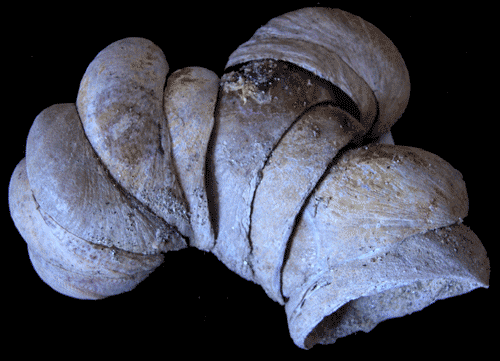
The first larvae to settle will be a female. She will be the larger one on the bottom of a Crepidula sex stack. Other larvae will land on her back and become males. Each male in turn will stretch their muscular penises down to the female for a little internal copulation. When the female dies, the next male in the stack will become the new female. This begins with the disintegration of that pesky penis.
3. Loricerfa and Cycliophora-What does gender even mean? Let’s do away with traditional moms and dads!
Gender what’s that. To say the reproductive life cycle of these groups complex or just plain freaky would be an understatement. The Loriciferans were first described in 1983 and since then around 20 species were described with at least 80 species waiting in the wings for their official names. However, Loricefera were known since the 70′s but because of there complex life cycle with a larva (Higgins-larva) that looks completely different from the adults, things got delayed. All the species range in size from 108-405 micrometers and live interstitially (between grains of sediment in the ocean). In several species, the larvae can develop 4-12 larvae inside them. All of these larvae look the same as the original. This is a B-movie horror plot if there ever was one. Imagining having a child, a few days later they have children of their own and all are identical. In the group, the life cycle varies from species to species and in the words of an expert “more confusingly, may vary depending on the feeding condition of the larva in the same species.” Imagine feeding your child creamed carrots instead of pureed peas n’ ham and sending your child down a completely different developmental and reproductive cycle. I’m sorry little Jimmy you like mashed bananas, you’re a hermaphrodite. In one species, larvae moult into an individual with no gonads. “O’ damn where did my testicles go?” In another species, the larvae are bigger than the adults and develop a humongous ovary. This ovary can threaten the existence of whole cities. That last part was made up. In the same species as directly above this larvae forms a cyst-like stage. More larvae then can grow inside of it which then moult, get very big, and form big ovaries. Does this remind anyone else of the plot of Gremlins? No water and no feeding after midnight!
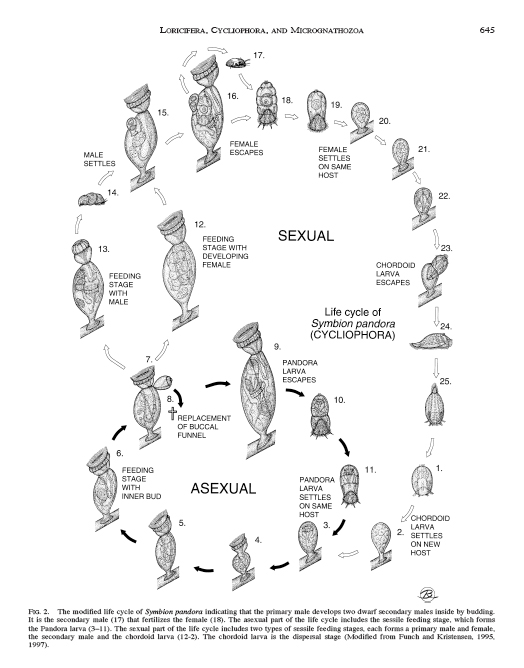
Another group recently described is only known from one species which lives on the setae of lobsters’ mouthparts. The group is Cycliophora and the species, Symbion pandora. Pandora because its lifecycle is a black box of evil, mystery, and of course really strange sex. That’s it in the diagram above. Yeah…complicated. There are both a sexual and asexual phase. A feeding and nonfeeding phases. A freaky phase and really freaky phase. The asexual phase has two types of feeding animals. The first type is called the Pandoral larva and houses the primary male and female inside a brooding chamber it does this by losing both its digestive system and head. I am told that human males also call loose there brains and replace them with reproductive organs. Budding is common. But not a new little you on the outside but new little you’s on the inside. Budding is internal. The sexual phase includes a primary male that lacks a penis or true testis. What’s the point then? That male settles on a feeding animal. If the feeding animal has a female inside this cues the male to develop some ‘equipment’. Howevever, the ‘equipment’ is not his own. He develops two males with a necessary gear.
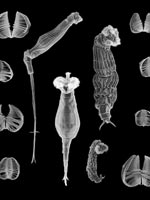 4. Bdelloid rotifers-No males and no sex in 80 millions years
4. Bdelloid rotifers-No males and no sex in 80 millions years
Has Ed Yong writes…
While many animals, from aphids to Komodo dragons, can reproduce asexually from time to time, it’s incredibly rare to find a group that have abandoned sex altogether. The bdelloid rotifers (pronounced with a silent b) are an exception. They live in an all-female world and since their discovery, not a single male has ever been found. Genetic studies have confirmed that they are permanently asexual, and females reproduce by spawning clone daughters that are genetically identical to them.
5. Osedax bone-eating worms-Harems not just for males
As Kevin eloquently described in his not necessarily PG rated post…
These chicas are freaky. But if you lived on a whale vertebrae and eat through bone, perhaps you’d be a little on the kinky side too, right? Osedax, the “bone-devouring” worm is weird…this is one critter that would infuse the pope with fear and disgust….What is really cool is that ALL whale bone-eating female worms appear to have dwarf males…There are many (up to 114 in Osedax rubiplumus) males fruiting around inside of a female in what is akin to an internal [word removed because it kept making me uncomfortable but read it in the original post if you dare] fest with the female enthralled in her detestable orgy, covered in the love ooze of her harem. In fact, Rouse et al. followed the worms through time and found that the larger, older ladies had a larger harem size.
Perhaps the Osedax is best describe in song
6. Nudibranchs-Sea slug shemales/hefemales blending the best of both sexes
All nudibranchs are simultaneous hermaphrodites enjoying all the best parts of being male and female at the same time (or maybe the worst parts of both). As opposed to many other animals where only a percentage of encounters would results in some funky fun time, any rendezvous with another slug can be fun. Durring sex both sea slugs will give and receive, give and receive and give and receive some more. However to make this work nudibranchs must continuously produce eggs and sperm. Imagine all the energy that takes. Nudibranchs must be consuming calories like an olympic weight lifter who then boinks all the other olympic weight lifters. Check out this great photo of nudibranchs in the act (NSFW?).
7. Anglerfish-Big females and small males are the norm
This may come as a shock but in most animals females are larger males. Insects, spiders, fishes, amphibians, and reptiles the males are diminutive and they like the ladies big. Even in groups, and the ones humans often first think of, where males typically get larger than females like mammals and birds, there are notable exceptions to these rules. In anglerfish, females are 10x larger the males. In fact males are essentially free living sperm packs. Anglerfish males on locating a female will bite her side. This biting triggers hormones that fuse his lips to her and dissolve his organs. Eventually, he becomes nothing more than a dangling testis on her side.
8. Wrasses-multiple sexual roles for males
In some wrasses, a group of 600 marine fishes, there are two types of males. One of the males looks like a female. These feminized males use it as a strategy to sneak in and mate with females without being seen by a large alpha male. Even looking like a female, allows these males to avoid bullying. However when the alpha male moves on or dies, BAM he goes all macho. Surprisingly or maybe unsurprisingly, being macho apparently makes him all stupid. Because the strategy he just employed not to long ago is then used on him by other males.
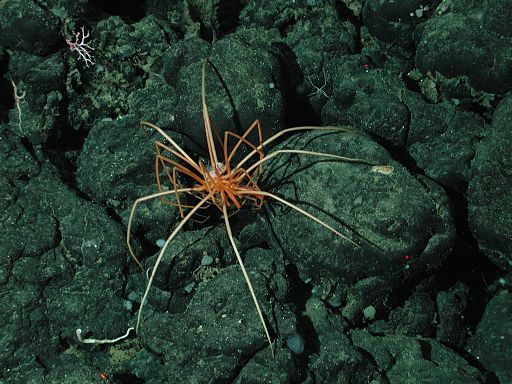
9. Pycnogonid sea spiders-Umm yeah…the pregnant legs of males
So where to start? Well let us begin with the fact that both females and males contain all sex organ in their legs. This is perhaps not shocking given pycnogonids are very spider like (but not spiders) with extremely long legs and very thin long bodies. There is pretty much no where else to put those gonads other than the legs. Males, like in seahorses, also take care of the young. Males keep these fertilized eggs also on their legs. Yeah I can’t even make this stuff up.
10. Cuttlefish -Transvestites for the win
Single males of the Giant Australian Cuttlefish will dress up like females by actively changing their patterns. Large alpha males fiercely guard their chosen female from all other males. In tactic simliar to the wrasses, this allows them to sneak in and make love with female while the large alpha male is none the wiser.
The post 10 Ocean Species That Challenge Gender Role Stereotypes first appeared on Deep Sea News.
]]>